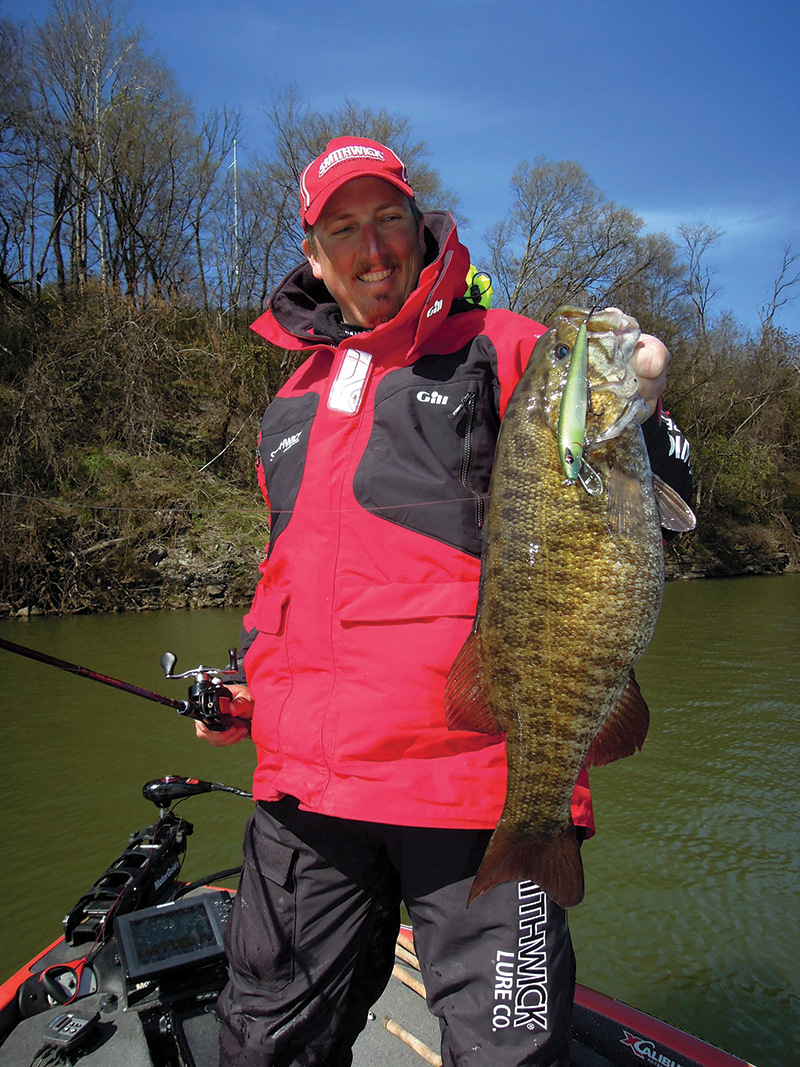Hot bass action in cold waters at Pickwick Lake
By John N. Felsher

Photo by John N. Felsher
Although anglers fishing Pickwick Lake in northwest Alabama might catch more than a dozen species on the same day, many people believe the reservoir could produce the next world record smallmouth bass.
The current world record smallmouth weighed 11 pounds, 15 ounces, a fish caught in Dale Hollow Reservoir on the Kentucky/Tennessee line in 1955. But Pickwick Lake produces smallmouth exceeding 10 pounds. In Wilson Lake, just on the other side of the Wilson Dam in Florence, Owen Smith set the Alabama smallmouth record with a 10.5-pounder. Both lakes also produce giant largemouth bass.
“Pickwick has really become one of the best bass lakes, not only in Alabama, but in the entire South for both largemouth and smallmouth,” says Tim Horton, a professional bass angler from Muscle Shoals.
Pickwick Lake spreads through 47,500 acres on the Tennessee River and touches Alabama, Mississippi and Tennessee. Dating back to 1938, the lake begins at the Wilson Dam and ends 53 miles downriver where the Pickwick Dam crosses the Tennessee River at Counce, Tenn.
Near Wilson Dam, the lake still resembles the old river channel. The Tennessee Valley Authority maintains the channel for commercial traffic so it averages 10 to 12 feet deep, but some holes drop to more than 50 feet deep. The lake spreads out as it flows toward the Mississippi-Tennessee line.
“Pickwick is both a river and a lake,” says Jimmy Mason, a bass pro and guide from Rogersville. “At the upper part, from the Natchez Trace Bridge to Wilson Dam, it’s a river. From the bridge toward Mississippi, it turns into more of a typical reservoir. The lower lake has a phenomenal amount of ledges, grassy flats and structure.”
Before spring spawn is time to catch biggest bass
Anglers often catch the biggest bass all year during the winter before the spring spawn. Although anglers frequently catch smallmouth and largemouth bass in the same spots on the same lures, smallies generally prefer cooler water, more current, deeper water and rocky bottoms.
Fishing on the reservoir generally improves when water flows through Wilson Dam. The currents flush baitfish and other forage downstream, kicking off a feeding frenzy. Even far downstream, current still positions fish.
“Typically, smallmouth go a little deeper and get in the eddies,” Mason says. “In the winter, I like to fish close to the flow, but still outside of it. I look for anything that breaks the current, like a rock pile, sand and gravel bars or islands. I look for current seams where fish can get behind something and don’t have to fight that current.”
From the Wilson Dam downstream to the Natchez Trace Parkway Bridge near Barton, the river flows around several islands, rocky shoals, sandbars and other obstructions. Like trout in mountain streams, bass wait in calm water behind current breaks watching for prey to flow toward their lairs. When bass see something they like, they swoop out into the current, snatch it and then return to their eddy.
“Those old rock rows are dynamite areas to catch smallmouth in the winter,” Mason says. “They create great areas where fish can get out of the main flow. When the river is flowing heavy, I like to fish those rock rows by drifting backwards with the current. I use the trolling motor to slow the boat drift and cast upstream. Then, I use the current to sweep my bait into the eddies.”
Since smallmouth often key on abundant threadfin shad, lures that mimic baitfish typically work best. Lure colors depend upon water clarity and sunshine intensity. In stained water on a sunny day, throw natural colors like pearl, blue glimmer or other shad colors. On a cloudy day with dirty water, throw brighter baits, such as chartreuse, white or something with a little orange in it.
Although anglers can catch smallmouth bass from dam to dam, the area from the Natchez Trace downstream towards Mississippi typically holds more largemouth. For largemouth, concentrate on weedy areas and woody shoreline cover. Some good places to fish include Yellow Creek, the birthplace of the Tenn.-Tom Waterway, Bear Creek and Coffee Slough.
 John N. Felsher is a freelance writer and photographer who lives in Semmes, Ala. He co-hosts a weekly outdoors show that is syndicated to stations in Alabama. For more on the show, see www.gdomag.com. Contact him through his website at www.JohnNFelsher.com
John N. Felsher is a freelance writer and photographer who lives in Semmes, Ala. He co-hosts a weekly outdoors show that is syndicated to stations in Alabama. For more on the show, see www.gdomag.com. Contact him through his website at www.JohnNFelsher.com





